Dr. Charles H. Mazel: Video Transcript
Hear Charles H. Mazel talk about his job. Download (mp4, 160 MB).
Introduction
My name is Dr. Charles H. Mazel and I am a Principal Research Scientist at Physical Sciences Inc., a small, private research and development firm in Andover, Massachusetts. I am also the President of NightSea LLC, a small spin-off of PSI that I run to develop specialized lights and filters so that sport and science divers can see and photograph fluorescence. A good portion of my research is involved with fluorescence in the sea—discovering what fluoresces, measuring the fluorescence properties, documenting the fluorescence with photography or video, and developing new equipment to improve the process of observing fluorescence. When I am in the office I work on data, make measurements in the laboratory, and develop new equipment to test the next time I am in the field.
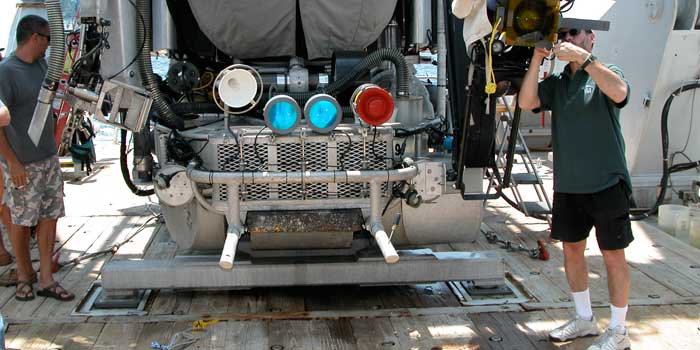
While at sea, Dr. Mazel was responsible for seting up the Johnson Sea Link to explore for florescence in the deep sea.
Mission Goals
On the Deep Scope mission, my job was to outfit the Johnson Sea Link to be ale to explore for florescence in the deep sea. This meant creating the filters for the cameras and the lights that let us explore for fluorescence down in the dark, making sure everything was installed and worked properly, and the executing the field work, getting in the sub and doing the exploration. One of the exciting things about this mission is just the thrill of going 2000 feet underwater in this plastic bubble and turning out all the regular lights and turning on all these special lights, and then cruising around the bottom, looking for things. It's a lot of fun. Deep Scope was a mission of exploration. We came back with a number of novel observations of animals and cases of fluorescence that had never been observed before.
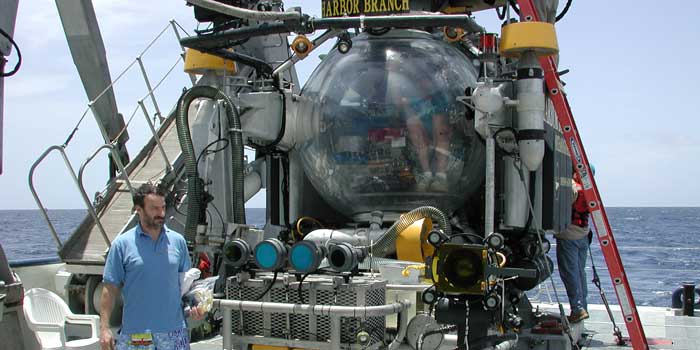
Dr. Mazel talks about life at sea, focus, dedication, and challenges.
Life At Sea
I think the thing I enjoy most about being at sea is just that, being at sea. It's good for my soul, it's something I like to do, and it's probably why I ended up gravitating towards marine research in the first place. Beyond that, I like solving challenges, getting out there and getting the job done with just the resources on hand. Things don't always go right, and you are left with your creativity of what you can do yourself and what you can do with others onboard the ship. I like that challenge. I also like the focus. When I'm in the office, the phone is ringing, I'm jumping between projects, there are lots of things to do. Once you get out at sea on a project, that's what you're doing. Once you're out at sea, you can really focus on one thing and do a really good job at it and dedicate yourself to it. There are several challenges working at sea. One is just the environment itself. A ship is really a small place, and if the weather is bumpy at all, it can be sometimes physically challenging. The real challenge is the fact that you are going to an isolated place. There's no radio shack, there's no hardware store. So you have to bring everything. You have to think ahead not only of what's going to work, but also what's not going to work, so that you can fix it and solve the problem out there.
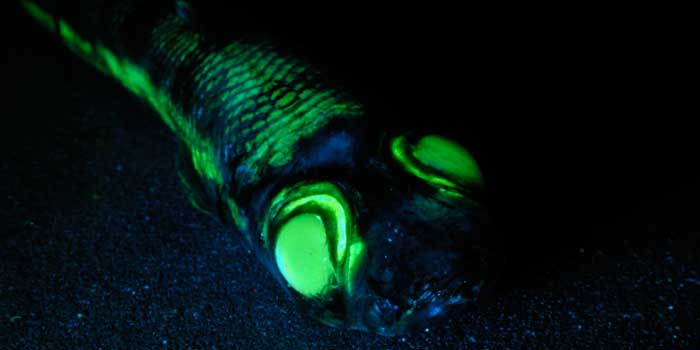
Dr. Mazel describes florescence and the filters necessary to see and record it.
Fluorescence
Fluorescence is the process of absorbing one light wavelength of color, and being able to reemit the same light at a different wavelength and color. It's like black light posters underwater, but instead of UV light, were using blue light. Regardless, it's the same process. When were looking for fluorescence we need a source of light to stimulate the organism. These things don't glow on their own. We can demonstrate this by using a really high intensity dive light, technology similar to that on the submersible. It takes a while to come up to full strength, but it creates a really bright white light. This white light has a lot of blue in it, and we can take advantage of this by slipping a blue filter over this light. This converts the white light source to a blue light source. Now if we went around shining this light on things, we'd just see the blue spot. We needed to block that blue to see the fluorescence. As a diver, you would wear a yellow filter that you would wear over your mask. In a submersible, we would simply wear a pair of glasses. For the sub, we have glasses that are comfortable to wear. You can sit back in the sphere and wear these yellow tinted acrylic glasses and see what the blue light is shining on the sea floor, and then alert the sub driver when you see something, a little to the left, a little to the right. In order to have the sub cameras see this, we slip on hefty filters that fit over the lights of the submersible. A safety line so that if it accidentally falls off, it doesn't drop to the bottom of the ocean. This turns the bright white lights of the sub into bright blue lights. For the camera, we have a yellow filter, just like the glasses. We have them custom fit to the camera. Underwater, the sub's manipulator arm can swing the filter into place. This allows you to perform white light photography and fluorescence photography. When we shine the blue light over the bottom, you really cannot tell if an object is fluorescent or not. You really need the yellow filter. When we pass the yellow filter over the camera, we see that the blue spot goes away, and you can see the glow from whatever you are looking at.
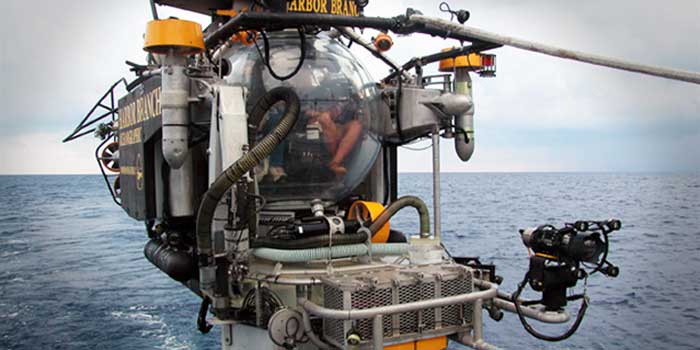
Charles Mazel describes the dive experience inside the Johnson Sea Link.
Diving In The Johnson Sea Link
During the dive, the sub is first lifted up off the deck by the frame, and swung over the deck and into the water. At that point, you're a passenger. The pilots are making sure of everything that's going on, making sure the seals are intact and that there's no water getting into the sub and that everything's working. Then you have a 25-30 minute ride, for the depths of which we were going to of 2000 feet. This is all straight down. It is very still. No motion. You have no perception of any motion. It's just getting darker and darker. I've been around the ocean for all my working life, and I've always just been drawn to it. I've always been around ships. I've been scuba diving. I've been on big ships, little ships. But to be able to go 2000 feet underwater, or more, is just an incredible thrill.
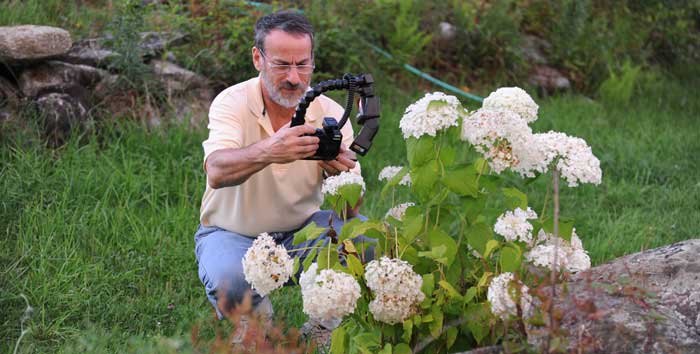
Words of Advice: "Take whatever opportunity you can to get experiences!"
Advice for the Future
My advice if you think you're interested in a career in marine science is to get as much experience as you can. At an early stage, you don't know what aspect of marine science you want to be involved in, what you're good at, what really gets you excited. Take as many opportunities as you can to get experiences, either by going to films, or by volunteering to work with people. Through these experiences, you can try to hone in to what you like, what you're good at, and you also start to get ideas about what needs to be done next. It pays to have brains, but hard work can triumph over brains any day, any time. It pays to dedicate yourself to what you're doing, and the key to that is to do something you like. To do something you like is to wake up at three in the morning and feel like you want to go to work.
Return to profile